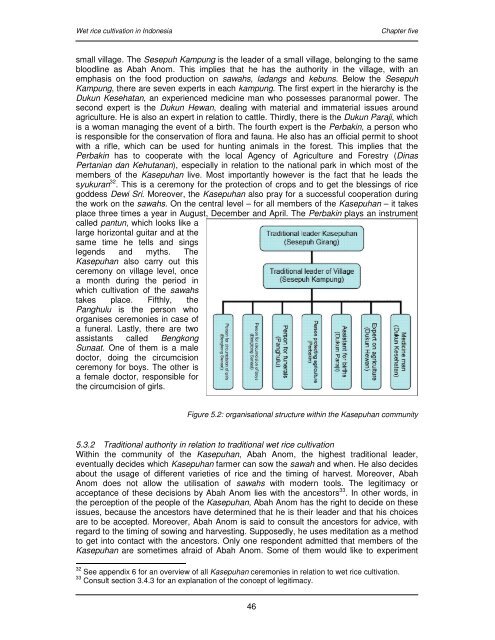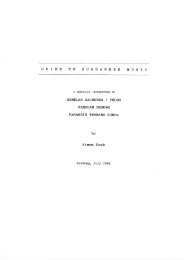Wet rice cultivation in Indonesia - Free EBooks Library
Wet rice cultivation in Indonesia - Free EBooks Library
Wet rice cultivation in Indonesia - Free EBooks Library
You also want an ePaper? Increase the reach of your titles
YUMPU automatically turns print PDFs into web optimized ePapers that Google loves.
<strong>Wet</strong> <strong>rice</strong> <strong>cultivation</strong> <strong>in</strong> <strong>Indonesia</strong> Chapter five<br />
small village. The Sesepuh Kampung is the leader of a small village, belong<strong>in</strong>g to the same<br />
bloodl<strong>in</strong>e as Abah Anom. This implies that he has the authority <strong>in</strong> the village, with an<br />
emphasis on the food production on sawahs, ladangs and kebuns. Below the Sesepuh<br />
Kampung, there are seven experts <strong>in</strong> each kampung. The first expert <strong>in</strong> the hierarchy is the<br />
Dukun Kesehatan, an experienced medic<strong>in</strong>e man who possesses paranormal power. The<br />
second expert is the Dukun Hewan, deal<strong>in</strong>g with material and immaterial issues around<br />
agriculture. He is also an expert <strong>in</strong> relation to cattle. Thirdly, there is the Dukun Paraji, which<br />
is a woman manag<strong>in</strong>g the event of a birth. The fourth expert is the Perbak<strong>in</strong>, a person who<br />
is responsible for the conservation of flora and fauna. He also has an official permit to shoot<br />
with a rifle, which can be used for hunt<strong>in</strong>g animals <strong>in</strong> the forest. This implies that the<br />
Perbak<strong>in</strong> has to cooperate with the local Agency of Agriculture and Forestry (D<strong>in</strong>as<br />
Pertanian dan Kehutanan), especially <strong>in</strong> relation to the national park <strong>in</strong> which most of the<br />
members of the Kasepuhan live. Most importantly however is the fact that he leads the<br />
syukuran 32 . This is a ceremony for the protection of crops and to get the bless<strong>in</strong>gs of <strong>rice</strong><br />
goddess Dewi Sri. Moreover, the Kasepuhan also pray for a successful cooperation dur<strong>in</strong>g<br />
the work on the sawahs. On the central level – for all members of the Kasepuhan – it takes<br />
place three times a year <strong>in</strong> August, December and April. The Perbak<strong>in</strong> plays an <strong>in</strong>strument<br />
called pantun, which looks like a<br />
large horizontal guitar and at the<br />
same time he tells and s<strong>in</strong>gs<br />
legends and myths. The<br />
Kasepuhan also carry out this<br />
ceremony on village level, once<br />
a month dur<strong>in</strong>g the period <strong>in</strong><br />
which <strong>cultivation</strong> of the sawahs<br />
takes place. Fifthly, the<br />
Panghulu is the person who<br />
organises ceremonies <strong>in</strong> case of<br />
a funeral. Lastly, there are two<br />
assistants called Bengkong<br />
Sunaat. One of them is a male<br />
doctor, do<strong>in</strong>g the circumcision<br />
ceremony for boys. The other is<br />
a female doctor, responsible for<br />
the circumcision of girls.<br />
Figure 5.2: organisational structure with<strong>in</strong> the Kasepuhan community<br />
5.3.2 Traditional authority <strong>in</strong> relation to traditional wet <strong>rice</strong> <strong>cultivation</strong><br />
With<strong>in</strong> the community of the Kasepuhan, Abah Anom, the highest traditional leader,<br />
eventually decides which Kasepuhan farmer can sow the sawah and when. He also decides<br />
about the usage of different varieties of <strong>rice</strong> and the tim<strong>in</strong>g of harvest. Moreover, Abah<br />
Anom does not allow the utilisation of sawahs with modern tools. The legitimacy or<br />
acceptance of these decisions by Abah Anom lies with the ancestors 33 . In other words, <strong>in</strong><br />
the perception of the people of the Kasepuhan, Abah Anom has the right to decide on these<br />
issues, because the ancestors have determ<strong>in</strong>ed that he is their leader and that his choices<br />
are to be accepted. Moreover, Abah Anom is said to consult the ancestors for advice, with<br />
regard to the tim<strong>in</strong>g of sow<strong>in</strong>g and harvest<strong>in</strong>g. Supposedly, he uses meditation as a method<br />
to get <strong>in</strong>to contact with the ancestors. Only one respondent admitted that members of the<br />
Kasepuhan are sometimes afraid of Abah Anom. Some of them would like to experiment<br />
32 See appendix 6 for an overview of all Kasepuhan ceremonies <strong>in</strong> relation to wet <strong>rice</strong> <strong>cultivation</strong>.<br />
33 Consult section 3.4.3 for an explanation of the concept of legitimacy.<br />
46








